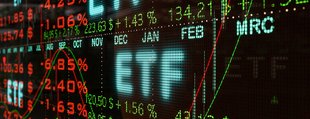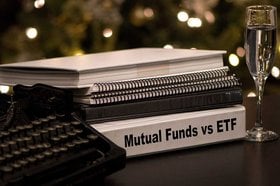12 Best ETFs For 2025: How to Invest, Pros & Cons
An ETF (Exchange Traded Fund) is like a mutual fund that invests in bonds, stocks, commodities, or other assets, except that it follows a predetermined index.
You trade ETFs like you would trade stocks on the stock market.
But there are thousands of ETFs, and figuring out which ones to dip your toes in can be overwhelming.
So we’ve selected the best ETFs to check out now. We’ll also share the different types of ETFs, tips on how to invest in them, and the advantages and disadvantages of investing in them.
And, if you’re looking for a more lucrative and stable investment option, we’ll give you the lowdown on investing in fine wine, and how to invest in it through Vinovest.
Further reading
- Ever heard of wine ETFs? Discover everything about them in this Complete Wine ETF Guide.
- Collecting fine wine is no longer for the elite - discover everything you need to know about Investing in Fine Wine.
12 Best ETFs to Explore in 2024
Below are the best ETFs to check out in 2024:
- Vanguard S&P 500 Index Fund ETF (NYSE: VOO)
- Vanguard Energy Index Fund ETF (NYSE: VDE)
- Vanguard Real Estate Index Fund ETF (BMV: VNQ)
- Vanguard Short-Term Bond Index Fund ETF (NYSE: BSV)
- Invesco S&P 500 Pure Growth ETF (NYSE: RPG)
- Freedom 100 Emerging Markets ETF (BATS: FRDM)
- SPDR Bloomberg 1-10 Year TIPS ETF (NYSE: TIPX)
- iShares Core S&P 500 ETF (NYSE: IVV)
- Distillate U.S. Fundamental Stability & Value ETF (NYSE: DSTL)
- Industrial Select Sector SPDR Fund (NYSE: XLI)
- United States Natural Gas Fund, LP (NYSE: UNG)
- Vanguard Total Stock Market Index Fund ETF (NYSE: VTI)
1. Vanguard S&P 500 Index Fund ETF (NYSE: VOO)
This Vanguard ETF is an attractive investment because it’s well-diversified in industries like technology, energy, and healthcare (think Coterra Energy Inc, Microsoft, and UnitedHealth Group).
The Vanguard SP 500 ETF accumulated over $887 billion in net assets, making it one of the most stable Vanguard funds with calculable cash flow for investors.

5-Year Performance Chart
Source: Google Finance
- Net Assets: $887 billion
- Average Volume: 3.76 million
- P/E Ratio: 22.65
- Yield: 1.52%
- Net Expense Ratio: 0.04%
2. Vanguard Energy Index Fund ETF (NYSE: VDE)
This passively managed Vanguard ETF invests in energy companies with diversified market capitalization.
Despite dips in the market, the energy sector (and VDE, by extension) has stood firm in 2022. This was especially noticeable when the S&P 500 dropped 20% during the first half of 2022.
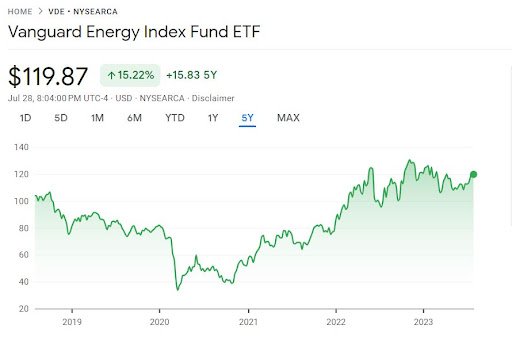
5-Year Performance Chart
Source: Google Finance
- Net Assets: $9.08 billion
- Average Volume: 548,516
- P/E Ratio: 7.68
- Yield: 4.07%
- Net Expense Ratio: 0.10%
3. Vanguard Real Estate Index Fund ETF (BMV: VNQ)
This Vanguard fund invests in stocks issued by real estate investment trusts (REITs). It tracks the MSCI US Investable Market Real Estate 20/50 Index.
This REIT ETF manages over $62.3 billion in net assets, surpassing competitors like BlackRock and Schwab. Vanguard also has large daily trading volumes, making it ideal if you’re trying to move large amounts of money.
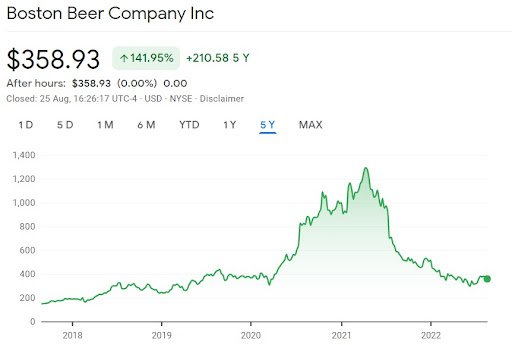
5-Year Performance Chart
Source: Google Finance
- Net Assets: $62.3 billion
- Average Volume: 4.84 million
- P/E Ratio: 23.49
- Yield: 4.52%
- Net Expense Ratio: 0.10%
4. Vanguard Short-Term Bond Index Fund ETF (NYSE: BSV)
This bond ETF focuses on short maturity periods (less than seven years). It’s one of the best Vanguard funds with low risk because it doesn’t fluctuate much when interest rates move.
It has about $63.17 billion in net assets in its portfolio, offering you access to a pretty good portion of the investment-grade, domestic fixed income market.

5-Year Performance Chart
Source: Google Finance
- Net Assets: $63.17 billion
- Average Volume: 3.02 million
- P/E Ratio: N/A
- Yield: 1.85%
- Net Expense Ratio: 0.07%
5. Invesco S&P 500 Pure Growth ETF (NYSE: RPG)
This ETF invests in public company stocks with high sales and earnings growth rates.
It uses various methods to measure value and growth and only lists companies categorized as deep growth. It’s a small fund with $1.89 billion of net assets under its management.
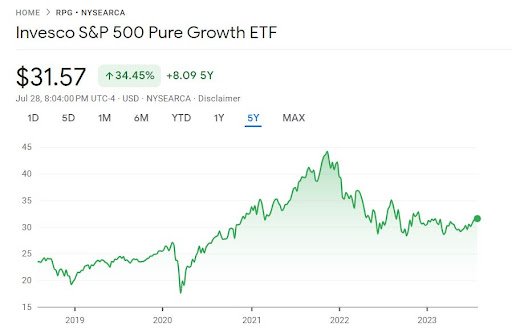
5-Year Performance Chart
Source: Google Finance
- Net Assets: $1.89 billion
- Average Volume: 244,059
- P/E Ratio: 2.44
- Yield: 1.40%
- Net Expense Ratio: 0.35%
6. Freedom 100 Emerging Markets ETF (BATS: FRDM)
This Emerging Markets ETF looks at the freedom-weighted and secondarily market cap weighted index. It focuses on large private companies in 10 of the freest countries in the world.
It evaluates this based on economic, political, and social liberties. This includes women’s rights, the rule of law, due process, freedom of press, religion, speech, and more.
As of 2022, the Freedom 100 Emerging Markets ETF features countries like South Korea, Taiwan, and Chile in the top 10.
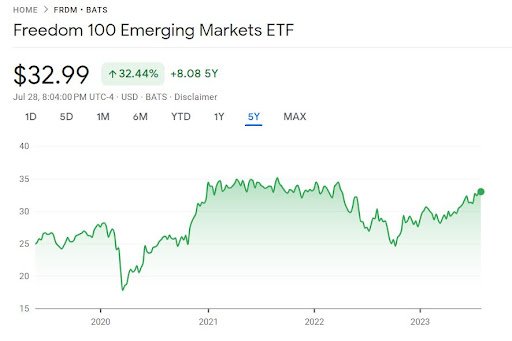
5-Year Performance Chart
Source: Google Finance
- Net Assets: $577.51 million
- Average Volume: 131,416
- P/E Ratio: 10.50
- Yield: 3.51%
- Net Expense Ratio: 0.49%
7. SPDR Bloomberg 1-10 Year TIPS ETF (NYSE: TIPX)
This ETF provides individual and institutional investors access to Treasury Inflation-Protected Securities (TIPS) with maturities between 1-10 years.
Its results correspond to the performance of the Bloomberg 1-10 Year US Government Inflation Linked Bond Index.
This TIPS ETF is a reliable investment that will help you hedge against inflation.

5-Year Performance Chart
Source: Google Finance
- Net Assets: $1.33 billion
- Average Volume: 390,295
- P/E Ratio: N/A
- Yield: 4.60%
- Net Expense Ratio: 0.15%
8. iShares Core S&P 500 ETF (NYSE: IVV)
The iShares Core SP 500 ETF provides access to the large-cap blend of the equity market. It has a market cap weighted portfolio of 600 small-cap stocks.
This iShares Core SP 500 ETF includes stocks from companies like Apple, Tesla, and Coterra Energy Inc. In the event of a market dip, an ETF like this is more likely to recover easily.
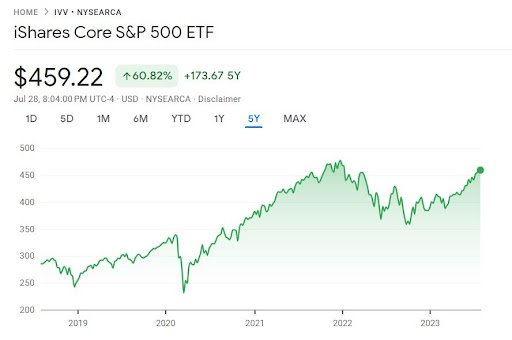
5-Year Performance Chart
Source: Google Finance
- Net Assets: $334.25 billion
- Average Volume: 4.01 million
- P/E Ratio: 23.04
- Yield: 1.48%
- Net Expense Ratio: 0.03%
9. Distillate U.S. Fundamental Stability & Value ETF (NYSE: DSTL)
Distillate U.S. Fundamental Stability & Value ETF offers you an attractive portfolio of 100 American large-cap stocks. This ETF focuses on quality and value, making it a great option for all kinds of individual and institutional investors.
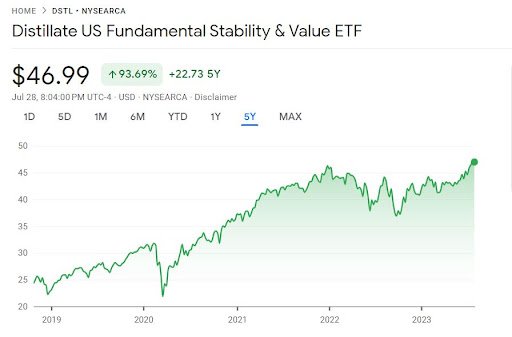
5-Year Performance Chart
Source: Google Finance
- Net Assets: $1.09 billion
- Average Volume: 109,767
- P/E Ratio: 19.49
- Yield: 1.26%
- Net Expense Ratio: 0.39%
10. Industrial Select Sector SPDR Fund (NYSE: XLI)
This fund focuses on stocks from financial companies in the S&P 500, like banking, REITs, insurance, consumer finance, and more.
In early 2022, its top holdings included Morgan Stanley, Bank of America Corporation, and Goldman Sachs Group Incorporated.
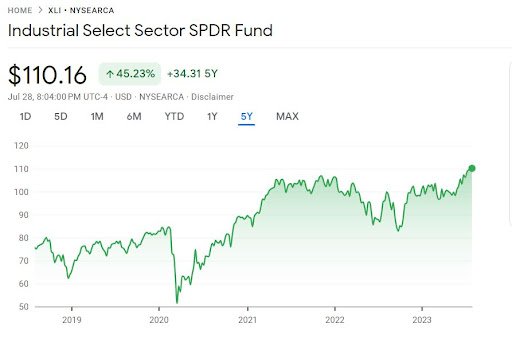
5-Year Performance Chart
Source: Google Finance
- Net Assets: $14.86 billion
- Average Volume: 10.67 million
- P/E Ratio: 23.66
- Yield: 1.59%
- Net Expense Ratio: 0.10%
11. United States Natural Gas Fund, LP (NYSE: UNG)
This fund tracks the movements of natural gas prices. You gain access to the natural gas market without having to invest in futures (which could be incredibly risky for you).
This fund invests in natural gas futures contract options, natural gas-related futures, and forward and swap contracts.
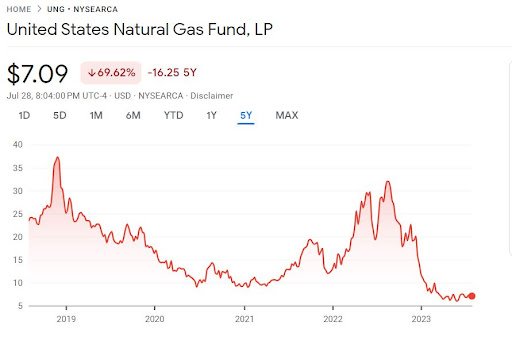
5-Year Performance Chart
Source: Google Finance
- Net Assets: $1.12 billion
- Average Volume: 18.87 million
- P/E Ratio: N/A
- Yield: 0%
- Net Expense Ratio: 1.06%
12. Vanguard Total Stock Market Index Fund ETF (NYSE: VTI)
The Vanguard Total Stock Market ETF tracks the CRSP US Total Stock Market Index.
This ETF’s portfolio has over 3,900 stocks, and its top sector is technology. Companies like Alphabet, Apple, and Microsoft make up 13.2% of the ETF.
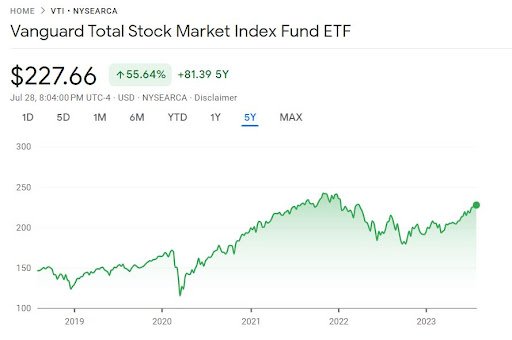
5-Year Performance Chart
Source: Google Finance
- Net Assets: $1.35 trillion
- Average Volume: 2.73 million
- P/E Ratio: 21.41
- Yield: 1.51%
- Net Expense Ratio: 0.04%
Apart from these ETFs, you can explore options like the Vanguard Dividend Appreciation ETF, the Schwab International Equity ETF, the Vanguard FTSE All-World UCITS ETF USD Acc, or the iShares MSCI Emerging Market ETF.
You can also check out a fixed income ETF like the Vanguard Total Bond Market ETF or currency ETFs like the ProShares Bitcoin Strategy ETF.
Now let’s take a step back and look at how Exchange Traded Funds work.
How Do ETFs Work?
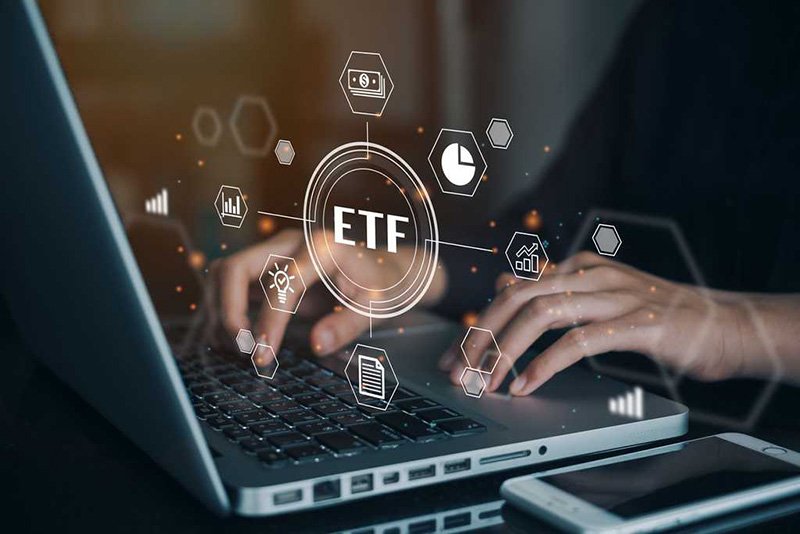
An ETF is a type of financial instrument that pools capital and invests it in different stocks, bonds, or other assets.
ETFs have specific stock collections (or themes). One is the S&P 500 index fund. Others include dividend stocks, growth stocks, disruptive technologies, healthcare, and more.
If you buy one share in an ETF, you purchase small shares in all the assets held in the fund.
Just like stocks, you can buy and sell ETFs on stock exchanges like the New York Stock Exchange, Nasdaq 100, and more.
Here’s one more thing you need to know:
The fund is typically managed by a brokerage firm that charges an expense ratio fee. This is the annual percentage of your total investment.
By now, you’re probably wondering:
What Is the Difference Between ETFs, Stocks, and Mutual Funds?
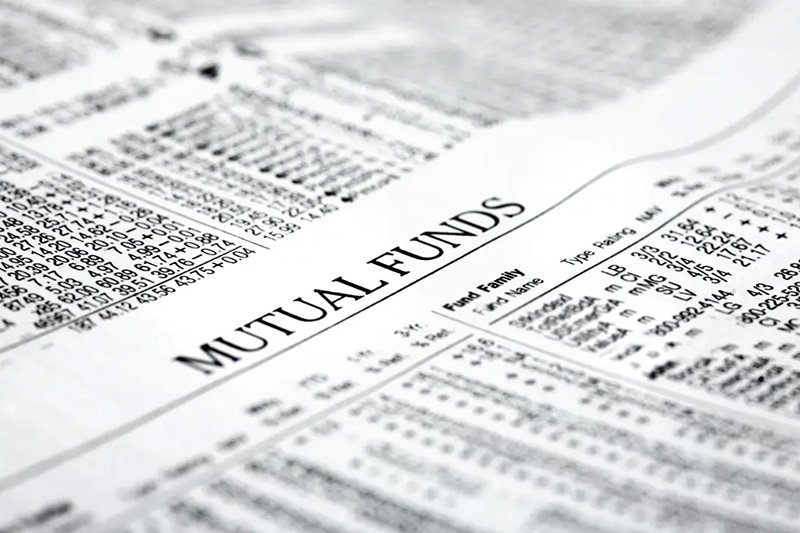
Simply put, ETFs represent a collection of assets, such as stocks, bonds, or commodities. They can be bought or sold throughout the trading day at a market price, similar to an individual stock.
Stocks represent ownership in individual companies. When you buy a stock, you become a partial owner and have a claim to the company’s assets and earnings.
Stock prices fluctuate based on supply and demand. This offers the potential for a high total return but comes with a higher risk compared to ETFs.
Mutual funds are pooled investment vehicles that invest in a diversified portfolio of securities based on a specific objective. Unlike ETFs, they’re priced at the end of each trading day based on the net asset value (NAV) of the underlying securities.
Now, it’s time to explore the different types of ETFs that are out there.
11 Types of ETFs to Choose From

As an investor, you probably have an investment objective for the year.
What’s a good approach to achieving your goals?
Mix and match different ETF types to find the most optimal combination.
So, what types of Exchange Traded Funds are available today?
- U.S. Market-Cap Index ETFs: This ETF gives you access to publicly traded companies on US stock exchanges. It uses a passive investment strategy to track major indexes (think S&P 500 or Dow Jones Industrial Average).
- International ETFs: These ETFs invest in publicly traded companies in foreign countries, including in an emerging market.
- Sector ETFs: Sector ETFs comprise stocks and securities in specific industries — think healthcare, technology, energy, consumer staples, and more. The best sector ETF worth checking out is the iShares US Consumer Staples ETF.
- Dividend ETFs: These ETFs passively track an index of dividend-paying entities.
- Long-Term Bond ETFs: These ETFs give you access to bonds with a long maturity period (think 20-30 years). The rates fluctuate according to the rise and fall of interest rates.
- Short-Term Bond ETFs: Here, you can invest in bonds with a short maturity period of about 1-5 years. A short-term bond ETF has low risk since it doesn’t fluctuate much when interest rates change. Note: As of September 2022, the Federal Reserve increased the federal funds rate (or interest rate) to 3%-3.25%.
- Bond Market ETFs: These ETFs give you access to long-term and short-term bonds, government securities, corporate bonds, and more. Since the Federal Reserve has increased interest rates, bond ETFs can help reduce interest rate risk in your portfolio.
- Municipal Bond ETFs: Here, you can invest in municipal bonds distributed by state and local governments. Their goal is to fund various projects (think bridges, schools, and highways).
- ESG ETFs: These ETFs focus on ESG investing, where companies commit to protecting the environment, social responsibility, and (or) governance.
- Gold ETFs: Gold ETFs are commodity ETFs that track only one asset — gold.
- Leveraged ETP: This includes leveraged ETNs (exchange-traded notes) and ETFs. It aims to amplify the total return on investment of an underlying index on a daily basis.
Next, let’s find out how you can invest in these ETFs.
How to Invest in ETFs in 3 Steps
Investing in ETFs isn’t that hard. Here’s what you need to do:
- Set Up a Brokerage Account
- Pick an ETF and Determine the Amount You Can Use for Investing
- Buy Your ETF
1. Set Up a Brokerage Account

Opening a brokerage account only takes a few minutes — you just need your social security and bank account numbers.
Look for an online brokerage account that has low fees or commission-free trading.
Different brokerage accounts have different benefits. For example:
- Some, like Charles Schwab and Fidelity, offer free ETF trades.
- Robo-advisors like Wealthfront will curate your ETF portfolio for you.
- Some firms offer a premium service with additional features (think asset allocation advice, timely alerts on when to trade, and more) for an extra fee.
You can even put your ETFs in tax-advantaged retirement accounts (think the 401K or Roth IRA).
2. Pick an ETF and Determine the Amount You Can Use for Investing

Picking an ETF depends on the ETF cost and how much you want to invest.
Firstly, compare the expense ratios of different index funds to identify the best option. From there, determine how much money you wish to invest.
Typically, you need to buy at least one share when placing an order. But some brokers allow fractional shares so that you can invest any amount of money — irrespective of the ETF’s market price.
3. Buy Your ETF
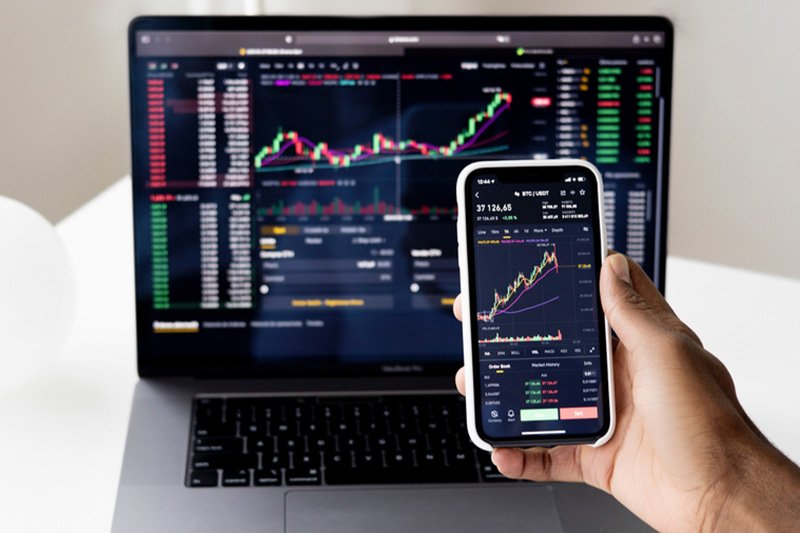
All you have to do now is make your purchase. Add funds to your account, wait till they clear, and then place the trade!
Remember to regularly add more funds to your account to ensure your earnings grow.
Now, everyone’s financial situation is unique. Before diving into one investment type, you must weigh the benefits and drawbacks of each.
5 Key Advantages of Investing in ETFs

Here’s a quick look at the benefits of buying ETFs:
- Good returns: As an investor, you’d be happy to note that ETFs produce good returns (about 10% annually). But that’s only if you pick the right funds.
- Portfolio Diversification: If you’d rather not buy an individual stock or spend time analyzing investments, ETFs are a good way to go. This will help you build a diversified portfolio comprising many top-performing companies.
- Low Management and Brokerage Fees: Most EFTs are passively managed, and cheap ones could cost about $8-$10 annually for every $10,000 invested. Traditionally, you’d have to pay your broker whenever you buy or sell an ETF share. But many online brokerage platforms do not charge any fees for trading an ETF share.
- Tax Efficiency: The structure of an ETF gives you some tax benefits. For example, the ultimate tax bill (the amount you have to pay after you sell an ETF and incur capital gains tax) is generally lower compared to that of a similarly structured mutual fund.
- Transparency: You’ll never have to worry about transparency. ETFs’ stockholdings and prices are readily available to anyone looking for information.
2 Disadvantages of Investing in ETFs

The main drawbacks of investing in ETFs are:
- Lack of Diversification in Some Sectors: In some industries, you may be limited to large-cap stocks because of the small number of equities in the market index. This could reduce your growth opportunities.
- Lower Dividend Yields: Dividend-paying ETFs may produce low earnings, especially compared to high-yield stocks.
Depending on your investment objective, you can diversify your portfolio with a good mix of short and long-term options (like gold).
Want a more lucrative investment option that has excellent long-term returns?
Try fine wine.
Fine Wine: A Consistent, High-Return Investment

Here’s why collectible wine is a wise investment option:
- Good Hedge Against Inflation: Fine wine prices usually increase when inflation rises.
- Low Volatility: Fine wine has little to no correlation to the stock market, so it’s less susceptible to market fluctuations.
- Exceptional Returns on Investment: Since 1988, fine wine has experienced a compound annual growth rate of about 11%. That’s not all: According to the Liv-ex 100 index, between 2021 and 2022, the average monthly ROI of fine wine investing was 22%. This is significant, especially compared to the S&P 500 index, which produced -5% returns during the same period.
The best part?
You don’t need to have vast wine knowledge to get going.
Investing in Wine Through Vinovest
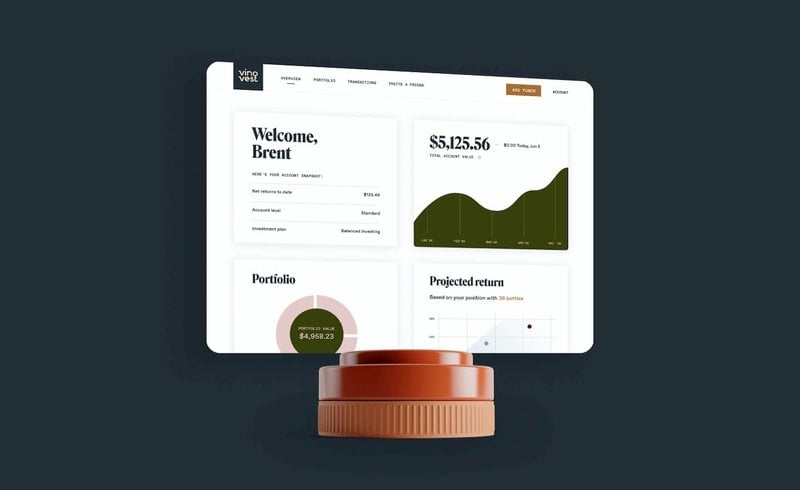
The easiest way to explore the world of collectible wine is through Vinovest — a world-class wine investment firm.
Vinovest takes the guesswork out of the process, helping you buy, store, and sell wine from anywhere worldwide.
Here’s the kicker:
Vinovest will:
- Store your bottles in climate-controlled bonded warehouses until you’re ready to sell or drink them.
- Arrange delivery to any location in the world.
- Provide guidance on the best liquidity options. So, when your bottles peak after 5-20 years, you’ll know exactly when to sell them and make a good profit.
Ready to get started?
Start investing with Vinovest in five easy steps:
- Sign up on the Vinovest website with your personal information (full name, contact number, and email address).
- Complete a brief form so Vinovest can understand your investment style and help you pick the right investment strategy.
- Fund your account with a minimum of $1,000.
- Using your answers, Vinovest will use its artificial intelligence to recommend stellar wines.
- Sip your favorite wine while you watch your portfolio flourish!
Grow Your Earnings With Smart Investment Choices

Whether you’re a novice or a pro investor, setting up an exchange traded fund is a great way to enhance your earnings.
Meanwhile, consider fine wine if you’d like to dive into the world of collectibles and benefit from excellent returns.
Check out the Vinovest website and discover how you can invest in the finest wines! Sign up with your personal information (like your email address) and allow the experts to help you build a profitable portfolio.
